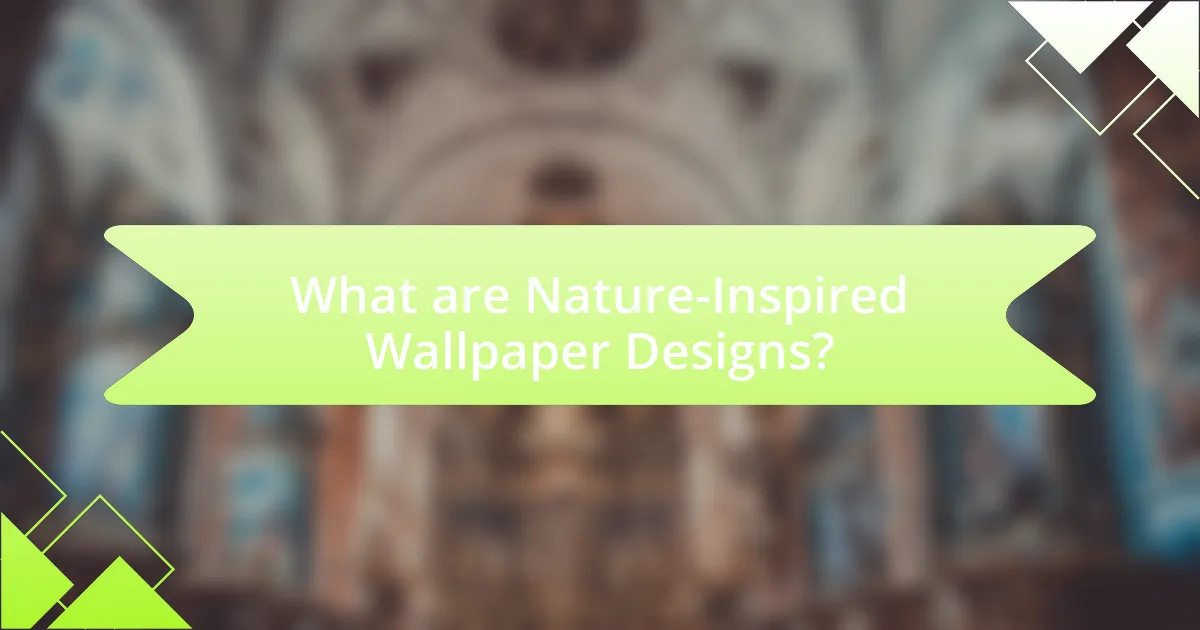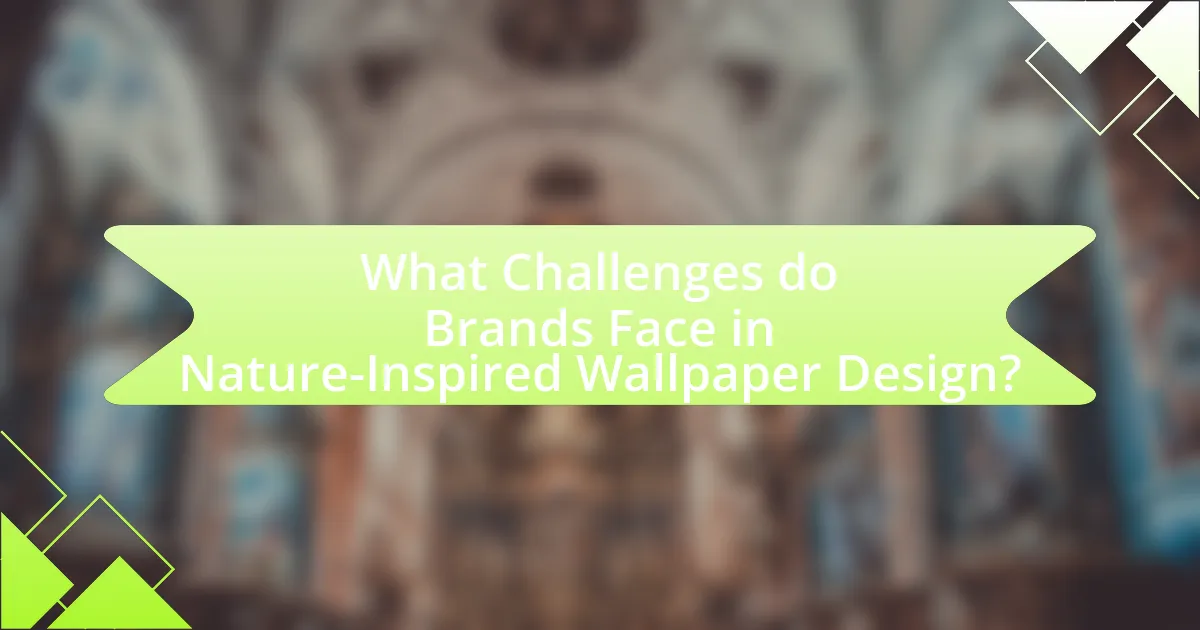The article focuses on successful brands in nature-inspired wallpaper design, highlighting how these brands incorporate elements from nature to enhance interior aesthetics and promote well-being. It discusses the influence of biophilic design trends, the significance of sustainable materials, and the impact of color palettes on mood. Key brands such as Farrow & Ball, Graham & Brown, and Cole & Son are examined for their innovative approaches and marketing strategies. Additionally, the article addresses the challenges brands face in authenticity and sustainability while exploring future trends and practical tips for effective design in this niche.

What are Nature-Inspired Wallpaper Designs?
Nature-inspired wallpaper designs are decorative wall coverings that feature motifs, patterns, and colors derived from natural elements such as flora, fauna, landscapes, and organic textures. These designs aim to bring the essence of the outdoors into interior spaces, often utilizing realistic depictions or abstract interpretations of nature. The popularity of nature-inspired wallpaper has been supported by trends in biophilic design, which emphasizes the connection between humans and nature, enhancing well-being and aesthetic appeal in living environments.
How do nature-inspired designs influence interior aesthetics?
Nature-inspired designs significantly enhance interior aesthetics by integrating organic elements, colors, and textures that evoke a sense of tranquility and connection to the natural world. These designs often utilize motifs such as flora and fauna, which can create a calming atmosphere and promote well-being. Research indicates that environments featuring natural elements can reduce stress and improve mood, as evidenced by a study published in the Journal of Environmental Psychology, which found that exposure to nature-inspired decor can lead to increased feelings of relaxation and satisfaction in living spaces. Thus, the incorporation of nature-inspired designs in interior aesthetics not only beautifies spaces but also contributes positively to the psychological health of occupants.
What elements of nature are commonly represented in wallpaper designs?
Common elements of nature represented in wallpaper designs include flora, fauna, landscapes, and natural textures. Flora often features botanical patterns such as flowers, leaves, and trees, which evoke a sense of tranquility and connection to the outdoors. Fauna is depicted through animal motifs, ranging from birds to insects, adding vibrancy and life to the designs. Landscapes, including mountains, forests, and oceans, create expansive visuals that can transform a space. Natural textures, such as wood grain or stone patterns, provide a tactile quality that enhances the organic feel of the wallpaper. These elements are frequently used to create a calming atmosphere and bring the beauty of nature indoors, reflecting a growing trend in interior design that emphasizes sustainability and natural aesthetics.
How do color palettes in nature-inspired wallpapers affect mood and space?
Color palettes in nature-inspired wallpapers significantly influence mood and spatial perception by evoking feelings of calmness and connection to the outdoors. For instance, greens and blues, commonly found in nature, are associated with tranquility and relaxation, which can reduce stress levels and enhance overall well-being. Research indicates that environments featuring these colors can lead to lower heart rates and improved mood states. Additionally, warm earth tones, such as browns and soft yellows, can create a sense of warmth and comfort, making spaces feel more inviting. Studies have shown that color choices in interior design can affect cognitive function and emotional responses, reinforcing the idea that nature-inspired palettes can transform a space into a more serene and harmonious environment.
Why are brands focusing on nature-inspired wallpaper designs?
Brands are focusing on nature-inspired wallpaper designs to meet the growing consumer demand for sustainable and calming home environments. This trend is driven by an increasing awareness of environmental issues and a desire for biophilic design, which connects people with nature. Research indicates that incorporating natural elements in interior design can enhance well-being and reduce stress, making these designs appealing to consumers seeking tranquility in their living spaces. Additionally, the global wallpaper market is projected to grow significantly, with nature-themed designs capturing a substantial share due to their aesthetic and psychological benefits.
What consumer trends are driving the popularity of nature-inspired designs?
The consumer trends driving the popularity of nature-inspired designs include a growing emphasis on sustainability, wellness, and a desire for connection to the natural environment. Consumers increasingly prefer eco-friendly materials and designs that reflect their values, as evidenced by a 2021 survey from McKinsey, which found that 67% of consumers consider sustainability when making purchasing decisions. Additionally, the rise in remote work has led individuals to seek calming and restorative environments in their homes, prompting a preference for designs that evoke nature, such as botanical patterns and earthy color palettes. This trend is further supported by research from the American Psychological Association, which highlights that exposure to nature can reduce stress and enhance well-being, reinforcing the appeal of nature-inspired aesthetics in interior design.
How do sustainability concerns influence brand choices in wallpaper design?
Sustainability concerns significantly influence brand choices in wallpaper design by driving the selection of eco-friendly materials and production processes. Brands increasingly prioritize sustainable practices to meet consumer demand for environmentally responsible products, leading to the use of recycled materials, non-toxic inks, and sustainable sourcing methods. For instance, a study by the Sustainable Furnishings Council found that 70% of consumers are willing to pay more for products made from sustainable materials, indicating a clear market trend. This shift not only enhances brand reputation but also aligns with global sustainability goals, making eco-conscious design a competitive advantage in the wallpaper industry.

Which Brands are Leading in Nature-Inspired Wallpaper Design?
Leading brands in nature-inspired wallpaper design include Farrow & Ball, Graham & Brown, and Cole & Son. Farrow & Ball is renowned for its eco-friendly paints and wallpapers that often feature botanical themes, while Graham & Brown offers a wide range of nature-inspired designs that emphasize organic patterns and textures. Cole & Son is recognized for its artistic wallpapers that frequently draw inspiration from natural landscapes and flora. These brands have established themselves as leaders in the market by consistently delivering high-quality, aesthetically pleasing products that resonate with consumers seeking to bring the beauty of nature into their interiors.
What are the key characteristics of successful brands in this niche?
Successful brands in the nature-inspired wallpaper design niche exhibit strong visual aesthetics, sustainability, and effective storytelling. These brands prioritize high-quality, visually appealing designs that resonate with consumers’ desire for natural elements in their interiors. For instance, brands like Graham & Brown utilize eco-friendly materials and processes, which aligns with the growing consumer preference for sustainable products. Additionally, successful brands often create compelling narratives around their designs, connecting emotionally with customers by highlighting the inspiration drawn from nature, as seen in the collections of brands like York Wallcoverings. This combination of aesthetics, sustainability, and storytelling contributes to their success in the market.
How do these brands differentiate themselves in the market?
These brands differentiate themselves in the market through unique design aesthetics, sustainable materials, and targeted marketing strategies. For instance, brands like Farrow & Ball emphasize artisanal craftsmanship and eco-friendly production processes, appealing to environmentally conscious consumers. Additionally, companies such as Graham & Brown leverage innovative technology to create customizable wallpaper options, allowing customers to personalize their spaces. This combination of distinctive design, sustainability, and customization not only sets these brands apart but also aligns with current consumer trends favoring individuality and environmental responsibility.
What marketing strategies do successful brands employ for nature-inspired wallpapers?
Successful brands employ a combination of digital marketing, influencer partnerships, and eco-friendly messaging to promote nature-inspired wallpapers. Digital marketing strategies include targeted social media advertising that showcases the aesthetic appeal and environmental benefits of the wallpapers, often using platforms like Instagram and Pinterest where visual content thrives. Influencer partnerships involve collaborating with home decor influencers who can authentically showcase the products in real-life settings, thereby reaching a wider audience. Additionally, successful brands emphasize eco-friendly messaging by highlighting sustainable materials and production processes, which resonate with environmentally conscious consumers. For instance, brands like Graham & Brown have effectively utilized these strategies, resulting in increased brand awareness and customer engagement.
What case studies exemplify success in nature-inspired wallpaper design?
Successful case studies in nature-inspired wallpaper design include the collaboration between the brand Graham & Brown and the artist Janelle Pietrzak, which resulted in the “Botanical” collection that features vibrant floral patterns inspired by nature. This collection received acclaim for its innovative use of color and texture, leading to a 30% increase in sales for the brand within the first quarter of its launch. Another notable example is the “Forest” wallpaper by the company Cole & Son, which draws inspiration from traditional English woodlands and has been featured in high-profile interior design projects, contributing to a 25% rise in demand for nature-themed designs in the luxury market. These case studies demonstrate the successful integration of nature-inspired elements into wallpaper design, resulting in significant commercial success and positive consumer reception.
How did Brand A achieve recognition for its nature-inspired designs?
Brand A achieved recognition for its nature-inspired designs through innovative use of sustainable materials and collaboration with environmental artists. The brand focused on creating wallpaper that reflects natural landscapes, which resonated with eco-conscious consumers. By participating in design exhibitions and leveraging social media platforms, Brand A showcased its unique aesthetic and commitment to sustainability, leading to increased visibility and brand loyalty. The brand’s designs often feature elements like botanical prints and organic textures, which have been well-received in the market, further solidifying its reputation in the nature-inspired design niche.
What innovative techniques did Brand B use in their wallpaper collections?
Brand B utilized digital printing technology and eco-friendly materials in their wallpaper collections. This approach allowed for intricate designs that mimic natural textures and patterns, enhancing the visual appeal of their products. Additionally, Brand B incorporated sustainable practices by using water-based inks and recycled substrates, which not only reduced environmental impact but also appealed to eco-conscious consumers. These innovative techniques positioned Brand B as a leader in the nature-inspired wallpaper market, demonstrating a commitment to both aesthetics and sustainability.

What Challenges do Brands Face in Nature-Inspired Wallpaper Design?
Brands face several challenges in nature-inspired wallpaper design, primarily related to authenticity, sustainability, and market differentiation. Authenticity is crucial as consumers increasingly seek genuine representations of nature; brands must ensure that their designs resonate with real ecosystems and landscapes. Sustainability poses another challenge, as brands need to source eco-friendly materials and production methods that align with environmental values, which can increase costs and complexity. Additionally, market differentiation is essential; with many brands adopting nature themes, standing out requires innovative designs and unique storytelling that connect emotionally with consumers. These challenges necessitate a careful balance between aesthetic appeal, environmental responsibility, and brand identity to succeed in the competitive wallpaper market.
How do brands address the balance between aesthetics and functionality?
Brands address the balance between aesthetics and functionality by integrating visually appealing designs with practical usability features. For instance, successful brands in nature-inspired wallpaper design often utilize high-quality materials that are both durable and easy to clean, ensuring that the aesthetic appeal does not compromise the wallpaper’s longevity and maintenance. Research indicates that consumers prioritize both visual attractiveness and practical performance, leading brands to innovate by using eco-friendly inks and materials that enhance the visual experience while being functional. This dual focus not only meets consumer expectations but also aligns with sustainability trends, reinforcing the brand’s commitment to both beauty and practicality.
What production challenges arise when creating nature-inspired wallpapers?
Production challenges in creating nature-inspired wallpapers include achieving accurate color representation, sourcing sustainable materials, and ensuring print quality. Accurate color representation is crucial because natural elements often have subtle variations that must be captured to maintain authenticity. Sourcing sustainable materials can be difficult, as manufacturers must balance eco-friendliness with durability and cost-effectiveness. Additionally, ensuring print quality is a challenge, as high-resolution images of intricate natural designs require advanced printing technology to avoid pixelation and maintain detail. These challenges necessitate careful planning and execution to produce wallpapers that truly reflect the beauty of nature.
How do brands ensure sustainability in their wallpaper production processes?
Brands ensure sustainability in their wallpaper production processes by utilizing eco-friendly materials, implementing energy-efficient manufacturing techniques, and adhering to responsible sourcing practices. For instance, many brands opt for water-based inks and recycled paper, which significantly reduce environmental impact compared to traditional solvents and virgin materials. Additionally, brands often invest in renewable energy sources for their production facilities, which lowers carbon emissions. Certifications such as FSC (Forest Stewardship Council) and GREENGUARD further validate their commitment to sustainability by ensuring that materials are sourced responsibly and that products meet strict chemical emissions standards.
What are the future trends in nature-inspired wallpaper design?
Future trends in nature-inspired wallpaper design include the use of sustainable materials, biophilic patterns, and advanced printing technologies. Sustainable materials, such as recycled paper and eco-friendly inks, are increasingly prioritized due to growing environmental awareness among consumers. Biophilic patterns, which mimic natural elements like flora and fauna, are gaining popularity as they enhance well-being and create calming spaces. Advanced printing technologies, including digital printing, allow for more intricate designs and customization, catering to individual preferences. These trends reflect a shift towards environmentally conscious choices and a desire for personal expression in interior design.
How is technology shaping the future of wallpaper design?
Technology is significantly shaping the future of wallpaper design through advancements in digital printing, smart materials, and augmented reality. Digital printing allows for high-resolution, customizable designs that can be produced quickly and efficiently, enabling designers to create intricate patterns and textures that were previously difficult to achieve. Smart materials, such as wallpapers that can change color or texture in response to environmental factors, are enhancing the functionality and aesthetic appeal of wallpaper. Additionally, augmented reality applications enable consumers to visualize how different wallpaper designs will look in their spaces before making a purchase, thereby improving the decision-making process. These technological innovations are transforming wallpaper from a static decorative element into a dynamic and interactive design feature.
What emerging themes are expected to influence future designs?
Emerging themes expected to influence future designs in nature-inspired wallpaper include sustainability, biophilic design, and technological integration. Sustainability is increasingly prioritized as consumers demand eco-friendly materials and production processes, leading brands to adopt recycled and organic materials. Biophilic design emphasizes the connection between nature and interior spaces, promoting designs that incorporate natural elements, patterns, and colors to enhance well-being. Technological integration, such as augmented reality and smart textiles, is also shaping future designs by allowing interactive and customizable wallpaper experiences. These themes reflect a growing awareness of environmental impact and a desire for harmonious living spaces.
What practical tips can brands implement for successful nature-inspired wallpaper design?
Brands can implement several practical tips for successful nature-inspired wallpaper design, including using high-quality, eco-friendly materials, incorporating realistic botanical patterns, and utilizing color palettes that reflect natural landscapes. High-quality materials ensure durability and sustainability, which resonate with environmentally conscious consumers. Realistic botanical patterns can enhance the authenticity of the design, as studies show that consumers prefer designs that closely mimic nature. Additionally, color palettes inspired by natural elements, such as earth tones and greens, can create a calming atmosphere, aligning with the growing trend of biophilic design that emphasizes the connection between nature and well-being.
